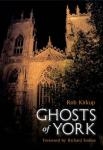
The venues they visited were: The National Railway Museum; the Best Western Dean Court Hotel; Gray's Court; York Tyburn; Siward's Howe; York Dungeon; ‘Haunted’ (35 Stonegate); Middlethorpe Hall Hotel; York Guildhall; and The Golden Fleece. Most of these visits were made by the group alone, though one was done in conjunction with another group, and one was as part of a commercially organised tour. Originally five in number, one person dropped out after the first trip, and there were sometimes only three participants. This was rather a small number for the sizes of some of the sites, necessitating a lot of moving around to cover likely spots. They had a variety of experiences, though mostly open to interpretation, and the words of one member before the final visit, “I have a feeling we‘re going to SEE something“, says a lot about the danger of expectancy effects in such situations.
It is often said that it is difficult for small closed-membership paranormal groups to find suitable establishments nowadays, given the involvement of companies turning a profit and venues wanting to maximise revenue. The penultimate visit, to the Guildhall, was arranged by such a company. There were almost twenty people in the party, and at one point they met another group who had been at ‘Haunted’ but had finished early and had decided to pay an impromptu visit. As Kirkup says, the problem with large groups is lack of control over the environment. Given the presence of these sorts of numbers, most of whom had never been on an investigation before but may well have harboured unrealistic expectations from watching TV shows, it is hard to see how any meaningful results could have been obtained. These organised events are not cheap, and while they may provide a frisson of excitement, it should not be assumed that they are providing anything other than immersive entertainment. Kirkup and his friends show that it is still possible for a small group to spend time on premises the owners have generously given free access to, though to be fair having a book contract probably opens a few doors.
The strength of Ghosts of York is that it is a warts-and-all account, down to an obsession with a particular sandwich shop and the extremely bulky coat one participant habitually wore. This is the stuff that usually gets left out, including reports of feeling completely knackered but extremely wired after late nights. The drawback is that they don’t do any deep research into the cases. A chapter is devoted to each location, there is a bit of background, the team describe what they did and anything odd that happened, then we move on to the next one. If the reader is looking for a survey of York ghosts, perhaps as a tourist guide, this is going to be a disappointment. However, there are plenty of those on the market. As a portrayal of what it is like to conduct a vigil this is a useful, if at times over-detailed, document that will hopefully encourage people to give it a go for themselves, rather than line the pockets of companies whose motive is profit, not the pursuit of psychical research, and who cannot be relied on for accurate information.
It is unclear why Kirkup’s band decided only to investigate ten sites, though one suspects it had something to do with that book contract, which gets mentioned a few times. This was not a formal ghost-hunting group – in fact they never even managed to come up with a name for themselves – but the dynamics seem to have worked well, and they clearly enjoyed what they did. That they found the experience satisfying is suggested by the hint of a sequel, set in a city even further north than York. It is doubtful whether descriptions of such vigils will ever provide evidence that would satisfy anybody who had not themselves been present, but while there’s a chance, why not?

